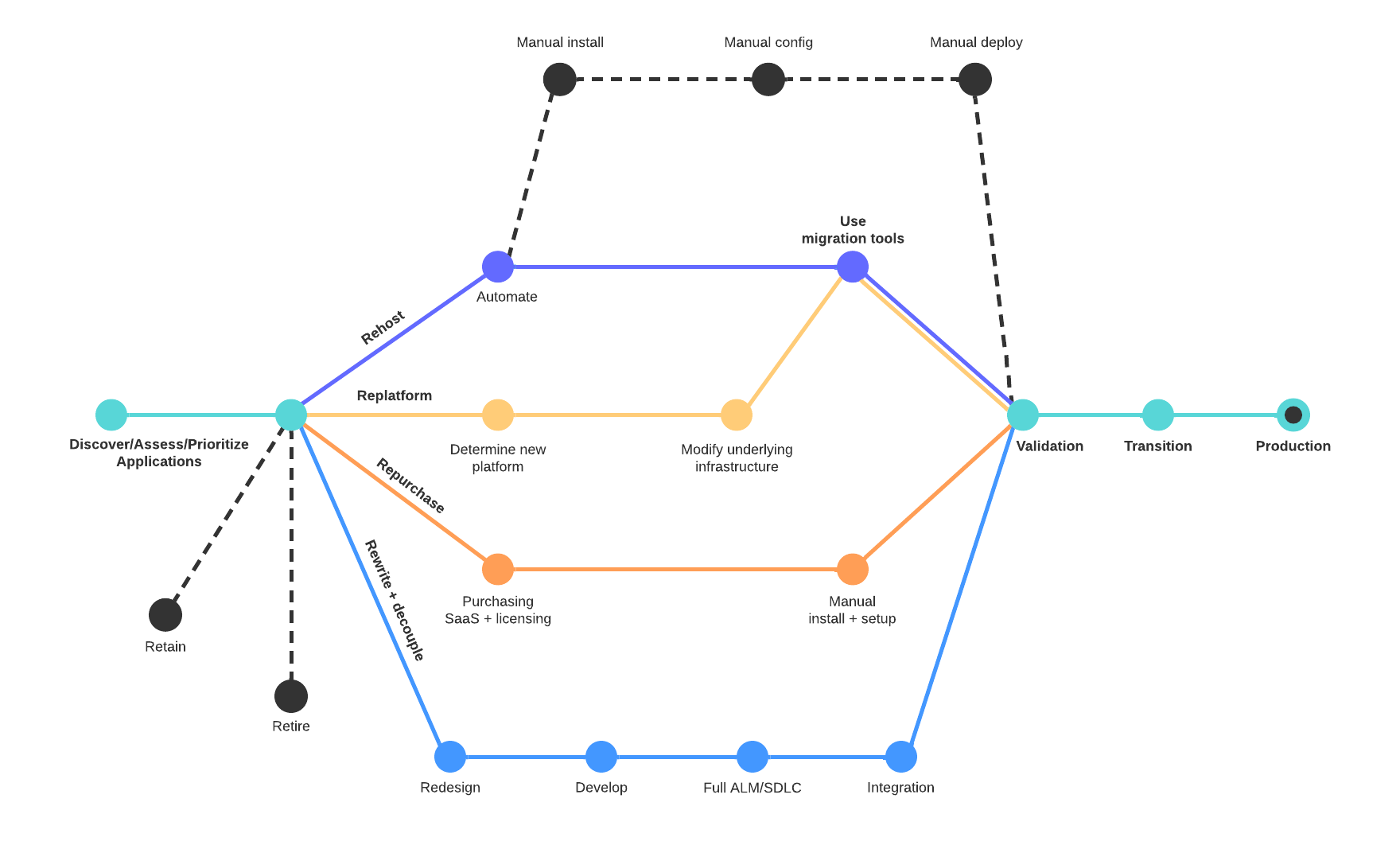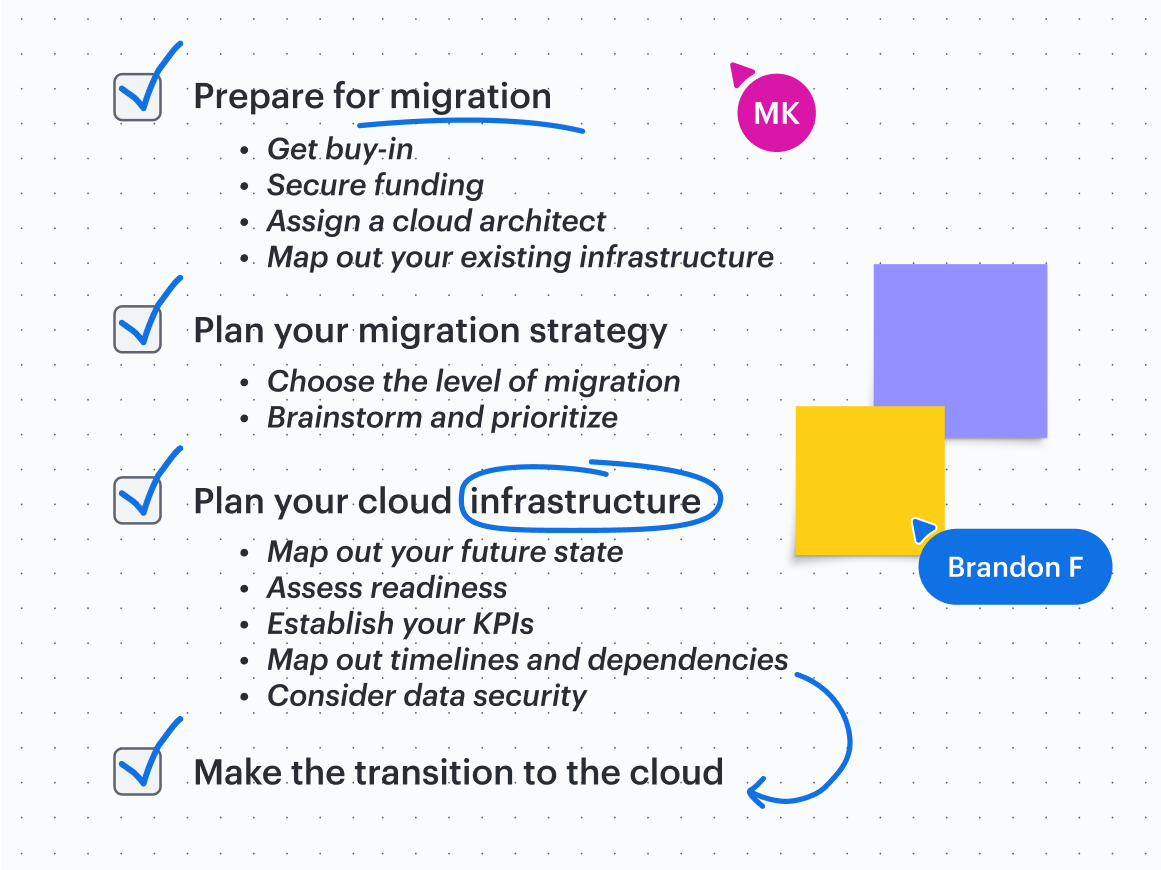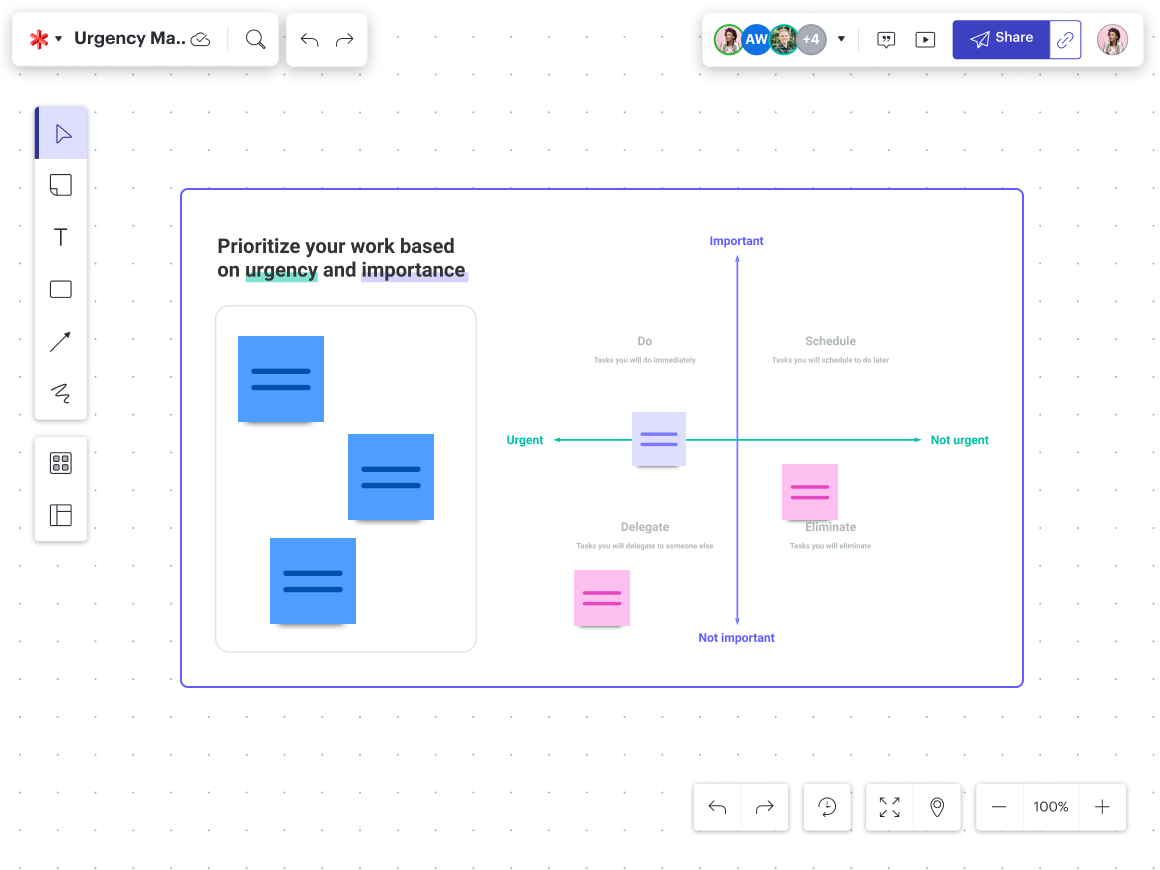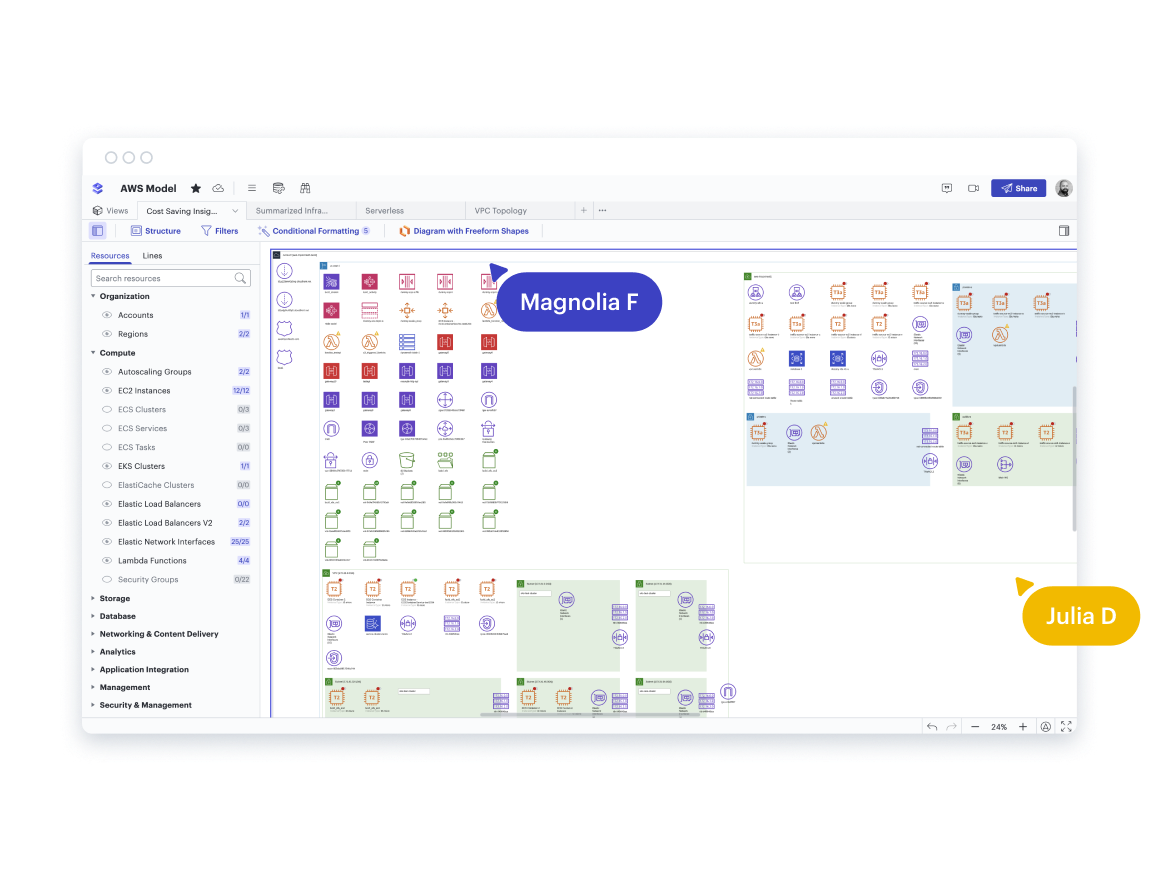
How to execute a successful cloud migration strategy [+ checklist]
Reading time: about 10 min
Topics:
Today, moving to the cloud is increasingly necessary. After all, cloud computing delivers key benefits, including increased IT effectiveness and efficiency, better security, greater scalability, and improved agility.
But cloud migration projects are complex, spanning multiple departments and months or even years. Teams need to come together for planning, prioritization, decision-making, designing new infrastructure, security and audit reviews, and more.
If your business is preparing to make the move to the cloud, use our checklist to keep your migration strategy on track.
The rise of cloud migration
When the name of the game is to disrupt or be disrupted, organizations are focused on the future, with digital transformation at the top of their priority list. And migrating on-premise computing infrastructure to the cloud is often at the center of these digital transformation strategies.
Many organizations have already begun their cloud migration journey, with 72% of top-performing organizations reporting that their company has achieved “all-in cloud adoption” in PwC’s 2024 Cloud and AI Business Survey.
And according to Gartner, by 2028, cloud computing will shift from being a technology disruptor to becoming a necessary component for maintaining business competitiveness.
Businesses are migrating some (or all) of their business processes, applications, and data (or using the cloud to build and later adopt new infrastructure) to adapt to this new digital landscape.
Benefits of migrating to the cloud
The ultimate goal of any cloud migration project plan is to host applications and data in the most effective way, based on cost, performance, and security. The cloud offers many advantages and solutions for digitally minded organizations, including:
- Greater flexibility
- Scalability
- Elasticity
- Tighter security
- Reduced costs
In a recent Deloitte survey of cloud decision-makers, respondents cited that cloud investment increases efficiency and agility (for 88% of respondents), creates new operational processes and workflows (87%), and mitigates business and regulatory risks (83%).
Increased cloud usage ultimately helps companies push their technology and businesses forward faster, ensuring companies stay competitive and relevant.

Cloud migration planning and execution checklist
Moving to the cloud isn’t a simple process. Businesses have to consider a number of factors, including security, costs, adoption, and even the type of migration. Between public cloud, private cloud, and hybrid cloud options, navigating the challenges of a cloud migration of any size can be a daunting task.
Use the following cloud migration checklist to create a cloud migration project plan and successfully move your operations to the cloud.

1. Prepare for migration
A successful migration relies on solid preparation. Check off the following to-dos to ensure you have a strong foundation to accomplish your cloud initiatives.
Get buy-in
As with any enterprise initiative, you need buy-in from the top down to ensure your migration is effective. Cloud migration is not solely the responsibility of your IT department but entails both technological transformation and cultural changes. Leadership and senior and executive staff need to provide guidance and support throughout the process.
Moving to the cloud can change the functional roles and operations of your business. Employees may need to be trained, reskilled, or reassigned to new roles to meet the needs of your evolving business.
To mitigate these growing pains, senior leadership should show public support and encourage buy-in at every level. To do this, leaders must communicate the benefits of the migration for employees and customers, address concerns, and support training programs.
Secure funding
Migrating to the cloud is, undeniably, a big financial commitment with a high upfront investment. In fact, most enterprises cite migration costs as a major inhibitor to adopting the cloud. Without proper planning and funding, your cloud migration could be a non-starter.
Make sure you secure proper funding ahead of time. You don’t want to find out midway through your migration that you’ve run out of funds, potentially leaving your network vulnerable to security lapses or failure.
Factors that affect cost include:
- Data storage
- Tools for testing and monitoring
- Processing power
- Security services
- Employee training and recruitment
CFOs, CIOs, CTOs, and other executives should work together to create a financial plan for the migration, signing off on funding.

What are the costs of cloud computing?
Discover the cost of cloud computing and ways to save.
Read the blogAssign a cloud architect
With executives on board and money in the bank, start digging into the nuts and bolts of your cloud migration project plan. First, you will need a cloud architect. Your cloud architect is your migration leader and, essentially, your cloud migration project manager: They are responsible for planning and executing each stage of the migration.
Their role includes:
- Defining the refactoring required for a successful migration
- Designing the strategies for the migration
- Defining the cloud requirements
- Determining migration priorities
There are many moving parts to a project plan for cloud migration. A good cloud architect will keep the migration on track from start to finish.
Map out your existing infrastructure
The next step of the preparation process is to understand your existing infrastructure. You have to know where you’re starting to get to where you want to go.
One of the best ways to do this is to visualize your network infrastructure. Lucidchart’s extensive shape library makes it easy to accurately build out your on-premise network. You can even create your own shapes in a custom library so you have exactly what you need to communicate your plans clearly with your team.
Visualizing your data and processes makes it easy for both IT and non-technical team members to understand business operations and transition to new systems and processes seamlessly.

Templates to kick-start documentation
Check out Lucid's template library to get started mapping out your existing infrastructure today.
Get started2. Plan your migration strategy
Once you’ve laid the groundwork for a successful migration, start planning your cloud migration strategy.
Choose the level of migration
Determine what level of migration you will be implementing. Not all organizations commit to a full migration—in fact, the majority don’t (and many can’t).
Shallow vs. deep integration
Cloud migration can be shallow or deep.
A shallow integration (also called lift-and-shift) involves moving your applications to the cloud as-is, with little to no changes to the applications except what is required to run them successfully in the new environment.
During a deep cloud integration, applications are modified so you can take advantage of cloud capabilities like auto-scaling, dynamic load balancing, and serverless computing.
Single cloud vs. multi-cloud vs. hybrid cloud
Organizations can migrate to a single cloud, multiple cloud providers, or even a hybrid cloud.
A single-cloud approach is typically simpler to implement but limits your service-level agreement terms and options. In other words, a single cloud is a one-size-fits-all approach. If your needs are simple or align with one vendor’s services, a single cloud integration may work just fine.
On the other hand, a multi-cloud approach, though more complex to integrate, offers businesses greater flexibility to create the environment they need.
A multi-cloud solution gives organizations the flexibility to pick and choose providers based on each vendor’s unique strengths and advantages. For example, you may rely on one provider to handle your data storage needs and another for serving applications in production.
A hybrid cloud is a combination of private and public cloud infrastructures that allow workloads to move between the two interconnected environments. This mobility between cloud environments gives organizations greater flexibility and agility in their data deployment options.
Brainstorm and prioritize
Bring all stakeholders together to brainstorm which applications or services make the most sense to move to the cloud. This should be a collaborative activity so you aren’t working in a silo.
You can use Lucidspark, a virtual whiteboard, to bring teams together on an infinite canvas. In this shared, virtual space, teams can contribute ideas, react to each other’s thoughts, voice questions and concerns, and reach alignment. If you started diagramming in Lucidchart, you can easily switch over to the Lucidspark toolset with the click of a button with Lucid’s universal canvas.
To better prioritize migration activities, try out Lucid’s Visual Activities to gather everyone’s input—live or asynchronously—and visualize areas of agreement or disagreement.

3. Plan your cloud infrastructure
With your strategy in place, you can now plan out just how you’ll execute the migration.
Map out your future state
With a clear picture of your current state, the next step is to map out your future-state plans. What will your future processes, cloud infrastructure, and environment look like? How will your new cloud infrastructure solve the problems of your current environment?
Categorize your workloads and desired outcomes so you can evaluate which cloud providers best meet your requirements. This step is crucial for scoping out a migration that anticipates and mitigates challenges and roadblocks during the process.
Use Lucidchart to map out future-state plans. Features like an extensive shape library and Visio stencil import for Cisco, AWS, Google Cloud, and Azure networks give you the tools you need to plan and orchestrate a seamless migration.
Assess readiness
After you’ve defined your future state, compare it against your current state to determine whether your applications can be migrated easily or if they will need remediation.
This readiness assessment provides a gap analysis of your organization and helps you identify which applications are ready for migration.
Establish your KPIs and performance baselines
Cloud migration is a big undertaking. How will you know if it was successful?
Establish your current performance baselines and define your key performance indicators (KPIs) so you can accurately measure your cloud performance. Your KPIs might include the following metrics to evaluate categories like user experience, infrastructure, and business engagement:
- Page load time
- Lag
- CPU usage percent
- Conversions
When you understand your baseline performance (i.e., current performance benchmarks), you can validate post-migration performance and even diagnose problems that arise during migration.
Features like data linking help you monitor your progress and ongoing performance right from Lucidchart. Simply link your metrics to your migration plans so you always have your finger on the pulse.
Map out timelines and dependencies
To ensure accountability and follow-through, you’ll want to break down the complex tasks of a migration project into easy-to-manage steps.
In Lucidspark, you can easily visualize timelines and milestones to proactively identify dependencies or roadblocks. The best part? You can sync Lucid Cards with your preferred system of record—such as Jira, Asana, Smartsheet, and many more—so any changes made in one platform will automatically reflect in the other platform.

Consider data security
Migrating to the cloud introduces unique security risks and challenges. As you plan your migration, there are a few key ways to ensure a secure transition:
- Encrypt sensitive data.
- Prioritize compliance.
- Create a data loss prevention plan.
- Conduct due diligence when researching service provider options.
You may also consider conducting a phased migration. Instead of migrating your workloads all at once, you can do so in batches to ensure every piece is fully secured and manageable.
4. Make the transition to the cloud
The last step is to dive in and make the transition to the cloud.
Though cloud migrations can be complicated, a well-laid plan can prepare you for a successful and manageable transition. Confidently start your transition with up-to-date diagrams and visual cloud migration project plans that are accessible to everyone involved.
After your cloud migration project is complete, you can use Lucid's Cloud Accelerator to validate deployment. Lucid integrates with AWS, Google Cloud, and Azure to automatically generate cloud architecture diagrams. Compare the actual state of the new cloud infrastructure against the designed state in Lucidchart to identify any discrepancies.

Simplify cloud migration with Lucid
Cloud migration is complex, but with Lucid, teams can align, plan, and collaborate throughout the entire project.
Visualizing your migration at each step of the transition lets you rely on a single source of truth when questions arise, ensuring everyone has the context they need to build a secure, compliant, and stable infrastructure.

Learn more about the way Lucid can help make your cloud migration a success.
Go nowAbout Lucid
Lucid Software is the leader in visual collaboration and work acceleration, helping teams see and build the future by turning ideas into reality. Its products include the Lucid Visual Collaboration Suite (Lucidchart and Lucidspark) and airfocus. The Lucid Visual Collaboration Suite, combined with powerful accelerators for business agility, cloud, and process transformation, empowers organizations to streamline work, foster alignment, and drive business transformation at scale. airfocus, an AI-powered product management and roadmapping platform, extends these capabilities by helping teams prioritize work, define product strategy, and align execution with business goals. The most used work acceleration platform by the Fortune 500, Lucid's solutions are trusted by more than 100 million users across enterprises worldwide, including Google, GE, and NBC Universal. Lucid partners with leaders such as Google, Atlassian, and Microsoft, and has received numerous awards for its products, growth, and workplace culture.
Related articles
[Guide] Cloud cost optimization strategies to increase visibility and alignment
Uncover the necessary—but often overlooked—strategies to gain complete cloud visibility, reach alignment, and reduce cloud costs.
Level up your cloud migration strategy with Lucid
In this blog post, we will explore how to level up your cloud migration strategy with Lucid.
The IT team’s toolkit for effortless documentation
Get over 15 templates to document systems, processes, and projects—without the hassle.
6 ways to use Lucid for your organization’s cloud initiatives (with real-world examples)
Check out the top ways Lucid has helped organizations accomplish their cloud initiatives.
